My life is currently a honey-covered disaster.
That’s not even a metaphor, I mean my life is literally covered in honey. Every surface in the kitchen, all of my pots and baking sheets, my computer, the cat, my hair… All honeyed. My iPhone case is a dead loss at this point (jury is still out on the actual phone.)
But, I mean, you guys have seen what happens to me when I paint…

So this should surprise no one.
You also know that I live for making messes, so I’m having a ton of fun with this…
Here’s how the honey gets from hive to jar. First, I pulled 20 “frames” of honey out of the hives. A capped frame (full of honey) looks like this…
(Horrible lighting, blah blah… the weather wasn’t great for this over the weekend so I ended up doing a lot at night. Still, you get the idea.)
The basic idea is to “uncap” the honey comb then put it in an extractor that spins the frames to get the honey out. Most beekeepers recommend a heated uncapping knife or plane (which I’ll definitely be investing in next year) but since this was my first year and I had a relatively small harvest, I spent $10 on some Miracle Blades (which are essentially just really thin knives) and then I rigged up this system with boiling water to keep the knives hot while I worked, switching them out periodically.
And here’s what it looks like when you’ve (mostly) uncapped a frame…
This year I rented a hand-crank, two-frame extractor (the cheapest of the cheap.) Two frames sit in the rack, you use the hand crank to spin the shit out of them and all the honey flies out, and then you turn the frames around and do the other side.
Then, after every couple of frames, I drained the honey out of the extractor, through a double-filter (to get all of the wax particles out), and into another bucket.
Here’s what a frame of comb looks like after most of the honey has been extracted…
These will actually go back in the hive next year. Since they are already drawn out and uncapped, the bees can spend their time filling them with honey instead of building the combs (which is why you get less honey the first year.)
Of all the things I ever thought I would do in my life, “staying up until 2AM on a Saturday night to bottle three gallons of honey” was never on the list. And yet…
Here we are.
And three days later I’m still in the process of filtering and bottling everything…
Next up will be constructing a solar oven to melt and filter the beeswax left over from the cappings. It won’t be a lot, but possibly enough for some lip balm or a small candle.
There are a whole lot of nuances to working with bees (and the process of extracting honey) that I’ve been learning as I go… one of them was not to walk up to the hives in the evening when you’ve removed a box of honey earlier in the day. Because ouch.
(It actually looks worse than it felt… itched like the devil, swole up like popeye, but never really hurt.)
One bee sting is a small price to pay for a few gallons of honey and a freezer full of comb honey though. Next year I’m planning to have more hives, more honey, and much better equipment (and processes) for handling honey-harvest… but between now and then you can find me scrubbing down every inch of my kitchen with hot water.
Or pretending to clean the kitchen, but really just munching on hot biscuits with honey…
Because, yum.
**A Quick Note About The Flow Hive (Or Whateverthefuck It’s Called)**
So, here’s a thing I have to say… I do know about the Flow hive that has been all the rage with crowdfunding this year. So many people have sent me a link to this thing, and I very much appreciate when people think of me and want to share a new and interesting idea, so I’ve been hesitant to share my actual thoughts on about it for fear that people would think I’m responding negatively to them and not the product. But here’s a real thing… I respond negatively to that product.
I don’t like it.
Even before I knew anything about beekeeping the Flow hive sounded like a gimmick, and now that I have some (albeit very limited) experience working with bees, I would never trust my hives to something like that, and here’s why:
- Getting in the hives is how you get to know your bees. It doesn’t disturb them or cause some kind of stress or frenzy… mostly when I check my hives my bees just keep doing what they’re doing, but I learn a whole lot about bee behavior, what’s going on the the hive, what I need to do next, and what questions I should ask. There’s a respect in actually doing the work with something like this–in treating a hive like the living organism that it is and not some kind of keg to be “tapped” on a whim. Even if this seemed like a plausible way to harvest honey and was good for the bees, it doesn’t feel like being a good steward to my hives.
- Unless you’re already an experienced beekeeper (or possibly in the most mild climate ever) you’ll lose your bees over winter. There’s just no way to know with that thing how many frames are full (and fully capped), or how much honey you’re taking if you’re not getting in the hive and actually looking at it. If you don’t leave enough honey for the bees to eat over winter, they’ll die. (And even if that doesn’t bother people, spending $150 dollars per hive every year to put a new package of bees in should. It doesn’t make any financial sense.) Maybe a very experienced beekeeper could read the signs on something like this, but I don’t think a new beekeeper (and I would bet anyone who buys this thing is a new beekeeper) would be able to make a good judgement about that. Not to mention, the way that it works “not disturbing the bees on the surface” while cracking the comb in the middle to remove the honey means the bees don’t actually know that the honey is gone. When I remove frames (or even damage a cell or two picking the frames up) the bees immediately know and “get to work” fixing or cleaning it. Without giving them those signs I think you’re handicapping their ability to provide for themselves (and probably causing even more “stress” when they crack open those cells to eat and realize there is no honey in there.)
- You’re still going to have to “work” the honey. Contrary to those beautiful marketing pictures, it’s not going to come out ready to spread on toast. It will still need to be filtered, and you’ll probably have to do even more work to judge the moisture content. The really awesome thing about bees is that they can judge the moisture content of the honey they make, and they don’t “cap” a cell until the honey is fully cured. If you have too much moisture in your honey it will ferment… and if you’re not pulling the frames out and seeing if they are fully capped you have no idea how much of the honey you collected was actually cured. And there will definitely be wax and other particles that will need to be strained out. Not to mention any honey that is outside an near a hive in an uncapped jar will immediately attract all kinds of bees, wasps, and other insects. If you leave an open jar of honey outside for just and hour or two, you’ll find drowned bees floating around in it for sure.
- I appreciate the engineering of the thing (I’m a problem solver, and I love people who dare to come up with a better mousetrap, so to speak) but even if it works the first year, my guess is the bees will have the thing so gummed up with wax and propolis by year two that it will basically be unusable.
I would never expect someone who hasn’t worked with bees to think about things like the moisture content in honey, or winter stores, or how bees react to changes in their environment… and I think that’s why the Flow hive sells. It feels like a great marketing scheme, but not a great beekeeping method. And I realize I’m not nearly experienced enough to say definitively that it won’t work long-term– so maybe I’ll be eating these words in a few years– but I trust what I’ve learned so far from my bees, and you won’t be seeing “honey on tap” on my farm anytime soon. I sure hope there will always be bees out here though, and I don’t mind the work (or the occasional sting) to keep it that way.
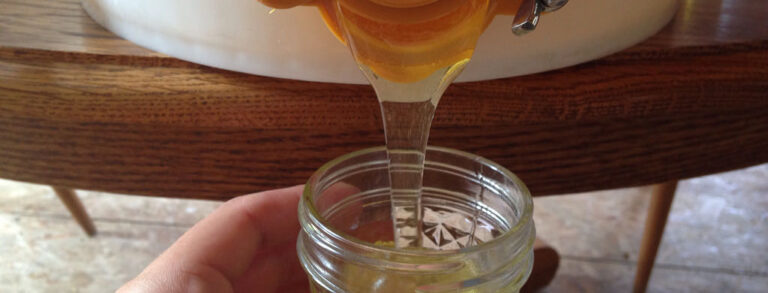

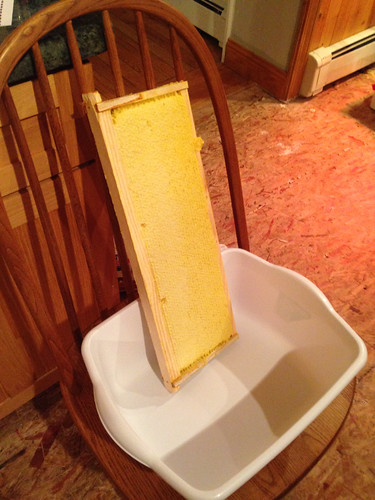

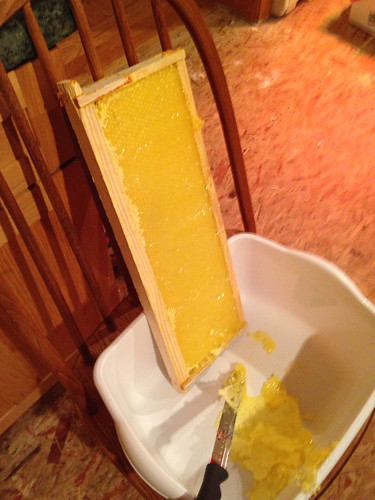
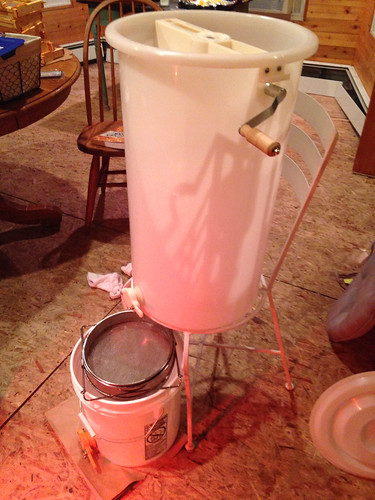
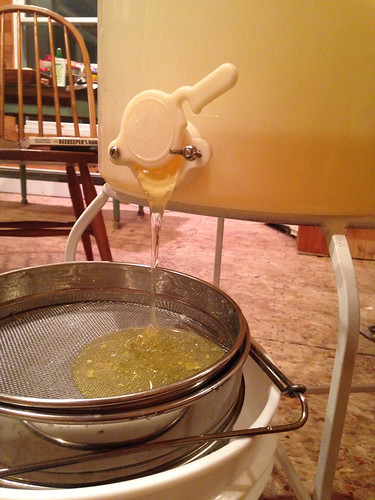

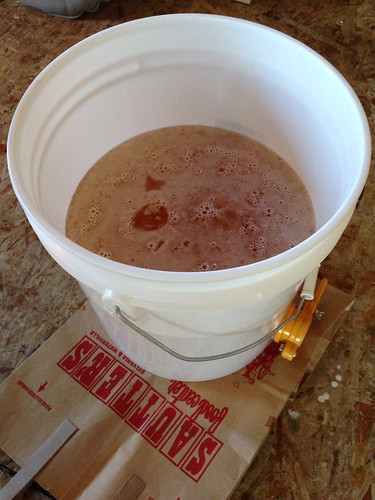
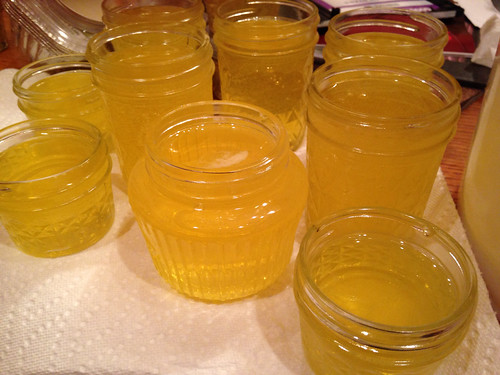
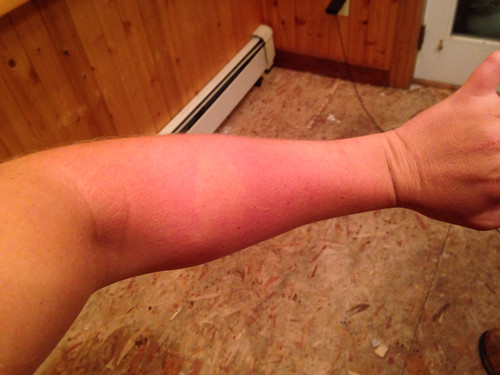


28 Responses
For some reason I read Adventures in BARkeeping and expected a really cool recipe for a cocktail named The Big Honey Harvest.
As someone who sent you that link in the past, I love to finally hear your insight on the product. You make very excellent points that I, not ever having kept bees nor planning to with my allergy, would have never thought of or known about.
Sorry to hear about your phone. If it’s a loss, don’t forget to take it off on your taxes. I’m not sure if even insurance would cover honey damage.
I don’t see how the phone damage loss would go on taxes. If you’re thinking Sched. A, note that is for loss from a “unexpected or unusual event such as a flood, hurricane, tornado, fire, earthquake or volcanic eruption. A casualty does not include normal wear and tear or progressive deterioration. “
Yes! I would never expect someone to know those things and LOVE when people think of me and send cool things my way, so thanks for that!
(I think the phone will probably make it 😉 )
“It feels like a great marketing scheme, but not a great beekeeping method.” *Exactly!*
Congrats on your first honey harvest!
It seems very light colored. Do you have any idea what their primary source of the nectar was?
It is very light, although I hear it darkens up over time. The fields around me (30 acres) didn’t get planted this year, and there’s a whole bunch of wooded areas/wetlands directly south of my property… I’m not sure what their primary source of nectar would be from that.
Judging from the color, maybe basswood (aka American Linden). Excellent honey from native trees. Soybeans also make really light colored honey.
Well that would make sense as there are bean fields all around! (Not sure about basswood…)
As a fellow beekeeper, I totally agree with your opinion. I put the frames out for the bees to “clean” before storing them. Great first harvest!
I leave my tools out all the time for the bees to clean (that’s how I got stung actually) but I’ve got a question about the frames…
I set up one hive with an empty (shallow) super on top of the inner cover and then put a full super of medium frames for them to clean on top of that. Since then I’ve seen pictures where people only have one frame in there at a time… do you have a certain way you let the bees clean the frames?
I put the empty frames back in the super and stand them up on the short side about 50 yards or so away from the bee yard. In learning from other beekeepers, I was told that if you put the empty supers too close to the hives that it could cause robbing. You know how it is, every beekeeper has their own way of doing things. This has worked well for me. The frames are very clean and ready for storing over winter. Aren’t bees awesome at what they do!
Yup, I went to a beekeeping class last year and the instructor shared your feelings on the Flow hive – for pretty much the exact same reasons!
Big congrats on your first year honey harvest Kit!
You mentioned it was a smaller amount but it is indeed quite a bit honey. I know more of marketing than than I do of bees but the part on you wanting to know your bees and their processes makes sense to me and not having to second guess this newfangled flo-max thingy that how many bee keepers in the area have used with success? I realize your working with honey here, but on something new and gimmicky sounding tailored to ” making things easier” I’d kinda like to see the proof in the pudding first.
I don’t eat the Colonel’s chicken any long, but when I did, plenty of biscuits with much honey was a very tasty part of the meal :)This bee keeping does seem to bee a rather busy business indeed. Hope you can salvage your phone n case.
Hats off to you for bee-ing a part of keeping bees in our world Kit 🙂 🙂
I don’t have any bee keeping experience or interest in it, but I am a scientist and I really enjoyed your thoughts on the product. A lot of new gimmicky products come out for any number of fields and it’s always great to hear someone with experience logically go through why they think it would or wouldn’t work.
This is my fourth year of beekeeping, and I 100% agree on the flow hive. I liken it to that magical shrinking garden hose on the infomercials. High on marketing, low on function, and doesn’t work at all after the first 10 minutes.
Great job on the harvest – in Texas you normally don’t get any honey your first year when you start with a package.
I just put the whole medium super back on and let them clean up the whole thing at once. I also have just set a super on its side with the frames in it (off the ground and away from the hives a bit) and let all the hives clean it up that way. I did that so I didn’t put multiple wet supers back on the same hive. Not sure that it would have mattered, or was the best idea, but it worked fine. Only thing I was a little worried about was whether it might set off some robbing, which is why I set it away from the hives a bit. I didn’t see any evidence of that happening though. As you have said, every single beekeeper does things a little differently – it’s all trial and error.
Not being a beekeeper, I too thought the Flowhive was a cool idea, but after reading your thoughts, it kind of makes me sad to think about all of the bees that won’t make it because of poorly maintained hives — compounded by the fact that a product like this was introduced to the market. So just a quick thank you for sharing, both your thoughts and your techniques. I hope more people do the same.
I am always impressed with the thought and work you put into your projects – especially with your animals. You treat your bees with the same degree of respect you treat your donkeys, chickens, and your cats. I really like that.
I meant cat, not cats. I think you only have one kitty, right? I have 6 little kitty defecators in my home.
I know nothing about beekeeping but I am very interested in the whole subject. I was going to make the same comment that your honey looks very pale, but for all I know that is normal. It makes sense that it would depend on where the bees are getting their nectar. It looks like you got a really nice harvest! And those biscuits and honey look heavenly!
Thanks for your thoughts on the Flow hive and giving me a new side on things. Lovely to see all the honey you collected too 🙂
Thanks for the great story and congratulations on your first honey harvest. You will have to try making mead with some of that honey. I tried my first bottle of blackberry mead a couple weeks ago. I don’t know what I am doing and I think it still tastes great! You should give it a try. Anyway, have fun with the bees.
One of my darling bar-owning exes is trying to talk me in to making mead… I might give it a shot!
I’d be delighted to sponsor your first mead-making adventure! I inherited some new-for-sale beer- and wine-making supplies when a friend took his home brew shop out of business. I am under strict instructions to find people interested in brewing and to share 🙂
If you want to add “make homemade mead” (homemead?) to your chalkboard, shoot me a note. I’ll ship over the buckets, hygrometer and yeast. It’s a slower process from pitch to sip than homemade wine from a kit or homemade beer, but I can attest to its 100% efficacy at erasing the pains of a hard day through pleasant intoxication!
Appreciate it… I have lots of friends around here that brew beer though, so I have all the equipment I could need!
I think the same principal can be applied to anything or any hobby that includes other living creatures. Beekeeping, dog showing, horseback riding. Someone can hand you the reins and you can have a good ride, but until you’ve picked a stall, groomed a horse or worked an agility course you can’t fully love and appreciate “your other half”.
Small creatures or large animals – you’d miss out on that bond that happens.
Looks like a ton of work, but look at those rewards! All that honey would last me pretty much forever.
I like reading through archives from time to time, and I just came across this post http://diydiva.net/2008/09/the-day-i-fell-in-love-with-bees/
It’s so cool to see how far you’ve come!
Yes! I forgot about that post (and also, in hindsight, I’m pretty sure that was a yellow jacket… but it all still applies!)
Comments are closed.